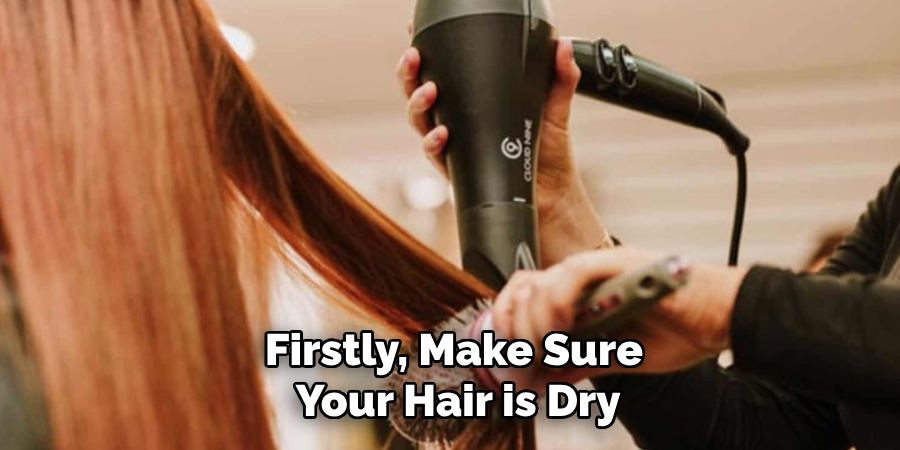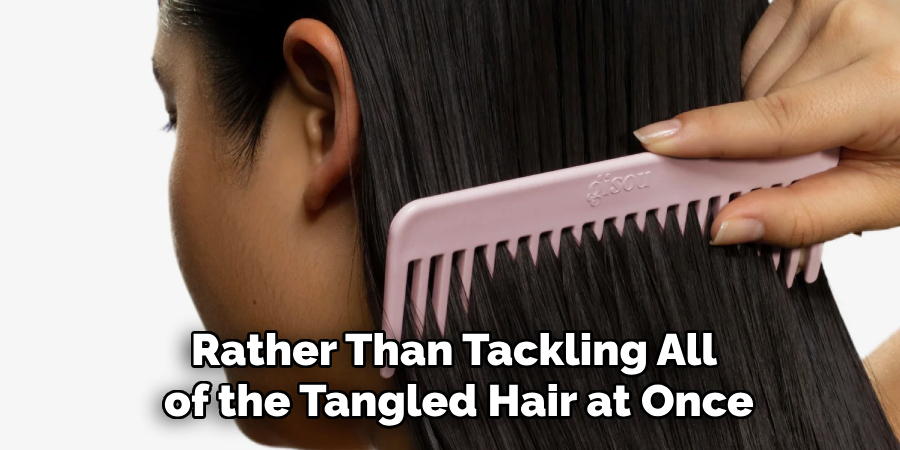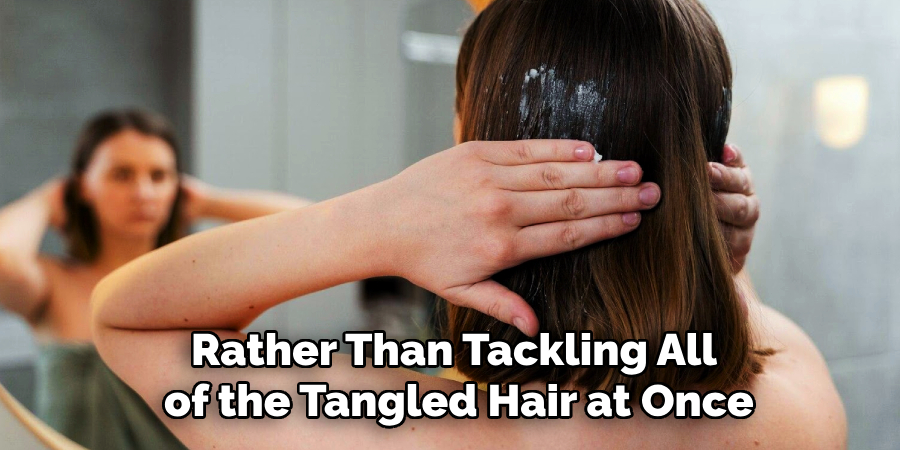Are you tired of repeatedly struggling to remove tangled hair from your round brush? Tangles can be frustrating, time-consuming, and damaging to both your hair and your brush.
Untangling hair from a round brush can be a frustrating and time-consuming task, but fear not! With a few simple techniques and some patience, you can quickly and easily free your hair from the clutches of the brush.

Whether you encountered a few snags while styling or have unintentionally wound your hair tightly around the bristles, this guide will provide you with step-by-step instructions on how to untangle hair from a round brush. Say goodbye to those hairbrush tangles and hello to smooth, manageable locks in no time! Let’s get started.
What Are the Benefits of Untangling Hair From a Round Brush?
Aside from the obvious benefit of having tangle-free hair, there are several other advantages to properly untangling your hair from a round brush:
- Lengthens the Lifespan of Your Brush: When you don’t remove tangled hair from your brush, it can cause excess stress on the bristles and damage or breakage. Regularly untangling your hair from the brush can prolong its lifespan and save money in the long run.
- Prevents Build-up: As you use your round brush, product residue, oils, and dirt can get trapped in between the bristles. If left uncleaned and with tangled hair mixed in, this build-up can lead to a less effective brush and cause more tangles in your hair.
- Promotes Hair Growth: Tangled hair can pull at the roots and potentially damage your scalp. Properly untangling your hair from a round brush promotes healthy hair growth by reducing the risk of breakage or damage.
- Saves Time: We all know how frustrating it can be to spend extra time in front of the mirror trying to remove tangles from our hair. By learning how to untangle hair from a round brush, you can save yourself time and hassle in your daily routine.
What Will You Need?
Before you can start untangling your hair from a round brush, make sure you have the following items on hand:
- A round brush (of course!)
- A comb with widely spaced teeth
- Hair clips or ties to help section of your hair
- A detangling spray or leave-in conditioner (optional)
Once you have these items ready, you can begin the untangling process.
10 Easy Steps on How to Untangle Hair From a Round Brush
Step 1: Prepare Your Hair and Brush
It’s important to prepare both your hair and the round brush before attempting to untangle it.

Firstly, make sure your hair is dry. Wet hair is more prone to tangling, so wait until your hair is dehydrated before trying to remove tangles.
Next, take a comb with widely spaced teeth and gently run it through your hair to detangle knots or snags. This will make it easier to remove tangled hair from the brush.
Step 2. Section Your Hair
To make the untangling process more manageable, divide your hair into sections. Start by parting your hair down the middle, creating two equal sections. Then, take each section and further divide them into smaller subsections using hair clips or ties. By sectioning your hair, you can focus on one area at a time, preventing tangles from spreading and making it easier to untangle each section without causing further damage or discomfort. Remember to secure any remaining hair out of the way with hair clips or ties to keep it from interfering with the untangling process.
Step 3. Hold the Brush Properly
When untangling your hair, how you hold the brush can make a significant difference in the process. Hold the brush by the handle, ensuring you have a firm grip to maintain control while being gentle. Position the brush at the ends of the tangled hair and work your way up gradually, using smooth and gentle strokes. Avoid pulling or yanking the brush through the tangles, as this can cause breakage and discomfort. Holding the brush properly and using gentle strokes can effectively untangle your hair without causing unnecessary damage. Remember to be patient and take your time to avoid any unnecessary stress on your hair strands.
Step 4: Separate the Tangled Hair

To effectively untangle your hair, separating the tangled sections from the rest of your hair is essential. This helps prevent further tangling and lets you focus on each knot individually. Use your fingers or a wide-toothed comb to carefully isolate the tangled strands, gently pulling them away from the rest of your hair. By separating the tangles, you can give them the attention they need without causing additional knots or snags. This step sets the stage for a more targeted and effective detangling process, ensuring smoother and easier brushing.
Step 5. Apply Detangling Spray or Leave-In Conditioner
To further ease the detangling process and minimize hair breakage, you may choose to apply a detangling spray or leave-in conditioner. These products work wonders by providing extra slip to the hair, making it easier for the brush or comb to glide through the tangles.
Detangling sprays typically contain ingredients that help soften the hair and reduce friction, while leave-in conditioners provide added moisture and nourishment. Simply spritz the detangling spray or apply a small amount of leave-in conditioner to the tangled sections of your hair, focusing on the ends where knots tend to form. Allow the product to penetrate the hair for a few minutes before proceeding to the next step.
Step 6: Work in Small Sections

It’s best to work in small sections rather than tackling all of the tangled hair at once. Start by gently brushing out the tangles from the bottom of each section and gradually working your way up towards the roots. This will help prevent any further knots or snags from forming.
Step 7: Be Gentle and Use Small Strokes
When untangling hair from a round brush, remember to be gentle and use small strokes. Avoid pulling or yanking on the tangled strands, as this can damage your hair and make the process more difficult. Instead, use small, gentle strokes while holding onto the ends of your hair to avoid putting too much stress on your scalp.
Step 8: Rotate the Brush
To further aid in untangling your hair from the round brush, try gently rotating the brush as you work through the tangles. Rotating the brush in a clockwise or counterclockwise motion can help loosen the hair strands from the bristles and make the untangling process smoother. Be careful not to forcefully rotate the brush to avoid causing additional knots or snarls. By incorporating this technique, you can enhance the effectiveness of the untangling process and achieve better results.
Step 9: Keep a Comb Handy
Having a wide-toothed comb within reach is essential during the untangling process. As you work through each section of hair, use the comb to separate any remaining tangles and smooth out the strands gently. The wide-toothed comb is particularly effective in preventing further breakage or damage to your hair, especially when dealing with stubborn knots.
Step 10: Finish off with a Hair Mask or Deep Conditioner

After successfully removing all tangles from your hair, providing some extra love and care to your locks is essential. Finish off the process by applying a nourishing hair mask or deep conditioner to restore any moisture lost during the detangling process. This step will help keep your hair healthy, shiny, and easy to manage between brushing sessions.
By following these ten steps, you can effectively untangle your hair from a round brush without causing damage or discomfort.
5 Things You Should Avoid
Here are five key things you should avoid when untangling hair from a round brush:
- Forcing the Brush Through: Avoid forcefully pulling or tugging the brush through the tangled hair. This can lead to breakage, hair damage, and pain.
- Using Excessive Heat: Avoid applying excessive heat to the tangled hair, such as using a hot blow dryer or straightener. Heat can make the hair more susceptible to breakage and worsen the tangles.
- Skipping Detangling Products: Avoid neglecting detangling products such as leave-in conditioners, sprays, or hair oils. These products can help soften the hair and make it easier to remove tangles.
- Brushing from Roots to Ends: Avoid starting at the roots and pulling the brush down to the ends in one stroke. This can make the tangles worse and cause unnecessary pain and hair damage. Instead, gently brush the ends of the hair and work your way up gradually.
- Not Being Patient: Avoid rushing through untangling hair from a round brush. Take your time, be gentle, and work through the tangles slowly and carefully to minimize hair breakage and discomfort.
By avoiding these common pitfalls, you can effectively and safely untangle your hair from a round brush, maintaining its health and integrity.
Conclusion
How to untangle hair from a round brush can be a frustrating and time-consuming task, but by following these tips and avoiding common mistakes, you can make the process easier and prevent damage to your hair.
Remember to be patient, use detangling products, and work gently through the tangles to achieve smooth and manageable locks. With these strategies, you can confidently use a round brush without worrying about getting tangled hair again.
So, next time you have a tangle emergency, remember these five things to avoid for successful untangling! Be mindful of how you approach the task of untangling hair from a round brush to keep your hair healthy and happy. Happy brushing!
About the Author
Jane Hubbard is a passionate beauty expert with a wealth of experience in makeup, hair, and overall beauty techniques. After years of working as a hairdresser specialist, she followed her entrepreneurial spirit and started her own consultancy business.
Jane has always been driven by her desire to help others feel confident in their own skin, and she does this by sharing her knowledge, experiences, and practical beauty tips. Through her consultancy, she empowers individuals to embrace their unique beauty, offering tailored guidance that boosts both self-esteem and personal style.
Professional Focus
- Specializes in makeup, hairstyling, and beauty consulting.
- Provides personalized beauty advice, tips, and techniques to help individuals feel confident in their appearance.
- Dedicated to staying up-to-date with the latest industry trends and developments.
- Passionate about creating a comfortable and empowering experience for every client.
Education History
- University of Craft and Design – Bachelor of Fine Arts (BFA) in Woodworking and Furniture Design
- Woodworking Apprenticeships – Extensive hands-on training with skilled craftsmen to refine carpentry and furniture making techniques
- Online Courses & Masterclasses – Continued education in advanced woodworking techniques, design principles, and specialized tools
Expertise:
- Makeup artistry, hairstyling, and beauty consulting.
- Personalized beauty techniques to enhance confidence and self-expression.
- Educating clients on how to maintain their beauty routines at home.
